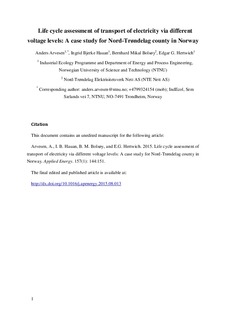| dc.description.abstract | Electricity transmission and distribution (T&D) plays a vital role in society by connecting electricity producers and consumers. We present a life cycle assessment case study of electricity delivery to consumers in Nord-Trøndelag county in Norway. We use a coherent framework for assessing electricity transfer via all the main segments of the Norwegian T&D system (local distribution, regional transmission and main national transmission grids). The assessment covers impacts associated with production, transport, and installation of components, power grid losses, and losses of sulphur hexafluoride. The results indicate that for electricity that is transmitted through the three main T&D grid segments, and assuming a Norwegian electricity mix when modelling the effects of power losses, the total carbon footprint of electricity T&D is 7.8 kg CO2-eq/MW h. Local distribution holds the largest share of this total (∼60%), while regional transmission and national transmission both make smaller but significant contributions (∼20% each). When classifying impacts as being attributable to either power grid losses or to other processes (e.g., materials and component manufacturing), both power losses and other processes contribute significantly to total impact potentials. Power losses are responsible for 30–43% of the combined electricity T&D impact potentials for climate change, particulate matter, smog-creation and acidification, 21–28% for toxicity and eutrophication, and 14% for metal depletion. For all categories except metal depletion, the relative importance of power losses increases appreciably if Nordic or particularly European electricity is assumed, however. Finally, we compare the environmental impacts of electricity T&D with that of electricity generation. The results of the comparison show that electricity T&D causes fewer impacts than electricity generation, but T&D impacts are not negligible; this is true regardless of what electricity mix is assumed when modelling power losses. | nb_NO |
